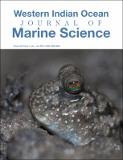| dc.description.abstract | Octopus cyanea is a commercially important cephalopod in the Western Indian Ocean (WIO) region, but scientific
information to inform management strategies for the species is limited. A study was conducted in 2014, 2015,
2017 and 2018 to investigate biological parameters including growth, mortality, exploitation rates and recruitment
patterns in the sea around Mafia Archipelago, Tanzania. Virtual population analysis (VPA) indicated differential
mortality between two sampling sites; the lowest and highest fishing mortality of F = 1.5yr-1 and F = 2.7yr-1 were
observed in Bwejuu (Dorsal mantle length, DMT = 18-20 cm) and Jibondo (DMT = 8-12 cm) fishing villages, respec tively. The maximum exploitation rate (Emax), which gives the maximum relative yield per recruit, was estimated
at 0.380 and 0.379 for Jibondo and Bwejuu, respectively. The exploitation rates E 0.5, which corresponded to 50%
of the unexploited stock relative biomass per recruit, were estimated at 0.248 for Jibondo and 0.247 for Bwejuu.
These values differ greatly from the exploitation rates of 0.53 and 0.41 for Jibondo and Bwejuu, respectively, sug gesting that the stock of O. cyanea is probably being overfished both in terms of yield per recruit and biomass per
recruit. The stock-recruit pattern was observed to be continuous year-round, with the peak being between May and
July. Since the peak in recruitment of both areas coincides with the south-east monsoon (SE Monsoon) and the level
of maximum sustainable yield has been overshot, it is recommended that management plans are implemented
that will reduce effort while increasing biomass, for example, implementing temporal octopus fishery closures at
a village level. | en_US |

